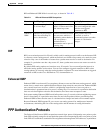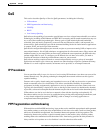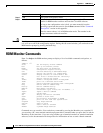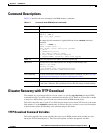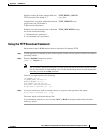
B-10
Cisco 1800 Series Integrated Services Routers (Fixed) Software Configuration Guide
OL-6426-02
Appendix B Concepts
QoS
In general, multilink PPP with interleaving is used in conjunction with CBWFQ and RSVP or IP
Precedence to ensure voice packet delivery. Use multilink PPP with interleaving and CBWFQ to define
how data is managed; use Resource Reservation Protocol (RSVP) or IP Precedence to give priority to
voice packets.
CBWFQ
In general, class-based weighted fair queuing (CBWFQ) is used in conjunction with multilink PPP and
interleaving and RSVP or IP Precedence to ensure voice packet delivery. CBWFQ is used with multilink
PPP to define how data is managed; RSVP or IP Precedence is used to give priority to voice packets.
There are two levels of queueing; ATM queues and Cisco IOS queues. CBWFQ is applied to Cisco IOS
queues. A first-in-first-out (FIFO) Cisco IOS queue is automatically created when a PVC is created. If
you use CBWFQ to create classes and attach them to a PVC, a queue is created for each class.
CBWFQ ensures that queues have sufficient bandwidth and that traffic gets predictable service.
Low-volume traffic streams are preferred; high-volume traffic streams share the remaining capacity,
obtaining equal or proportional bandwidth.
RSVP
RSVP enables routers to reserve enough bandwidth on an interface to ensure reliability and quality
performance. RSVP allows end systems to request a particular QoS from the network. Real-time voice
traffic requires network consistency. Without consistent QoS, real-time traffic can experience jitter,
insufficient bandwidth, delay variations, or information loss. RSVP works in conjunction with current
queuing mechanisms. It is up to the interface queuing mechanism (such as CBWFQ) to implement the
reservation.
RSVP works well on PPP, HDLC, and similar serial-line interfaces. It does not work well on
multi-access LANs. RSVP can be equated to a dynamic access list for packet flows.
You should configure RSVP to ensure QoS if the following conditions describe your network:
• Small-scale voice network implementation
• Links slower than 2 Mbps
• Links with high utilization
• Need for the best possible voice quality
Low Latency Queuing
Low latency queuing (LLQ) provides a low-latency strict priority transmit queue for real-time traffic.
Strict priority queuing allows delay-sensitive data to be dequeued and sent first (before packets in other
queues are dequeued), giving delay-sensitive data preferential treatment over other traffic.




